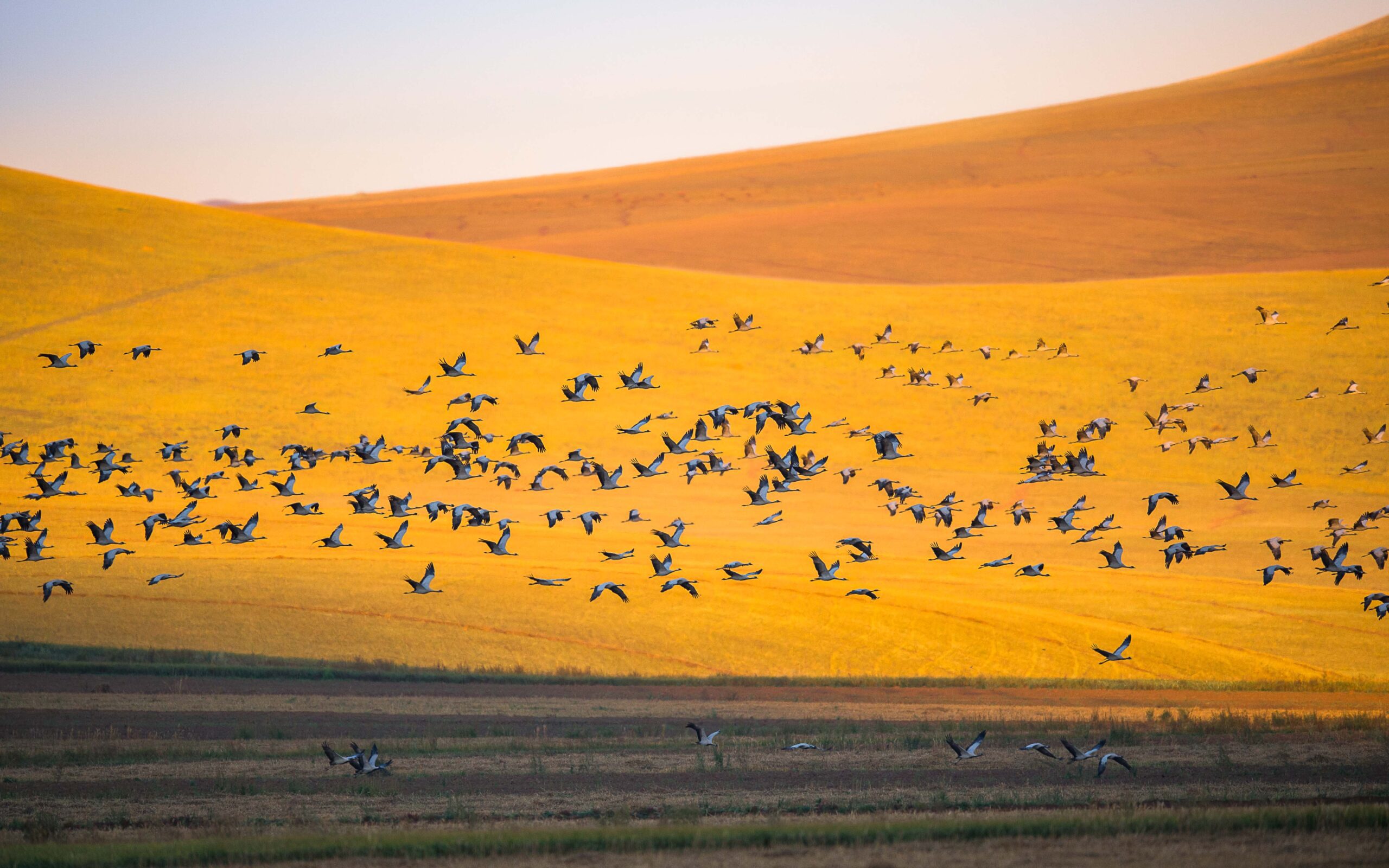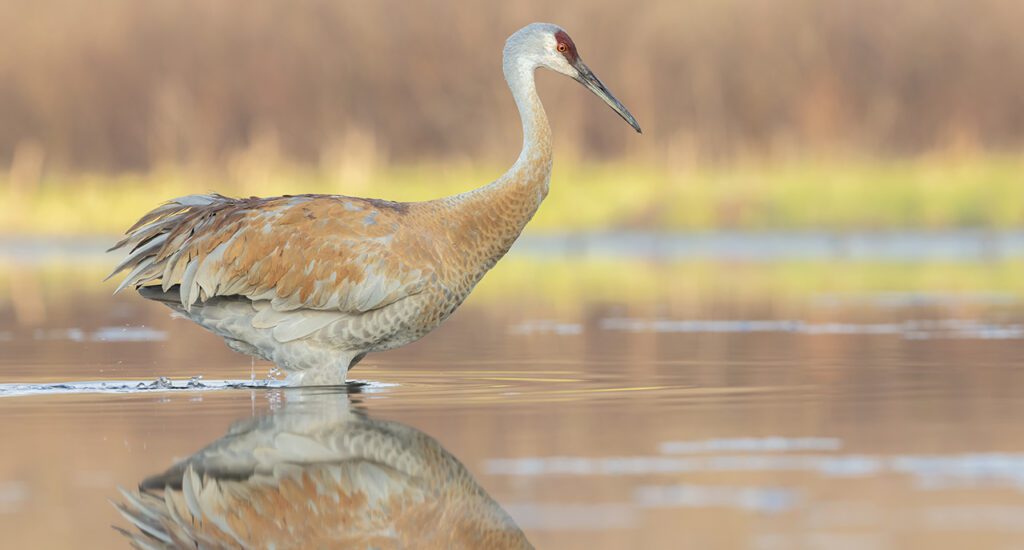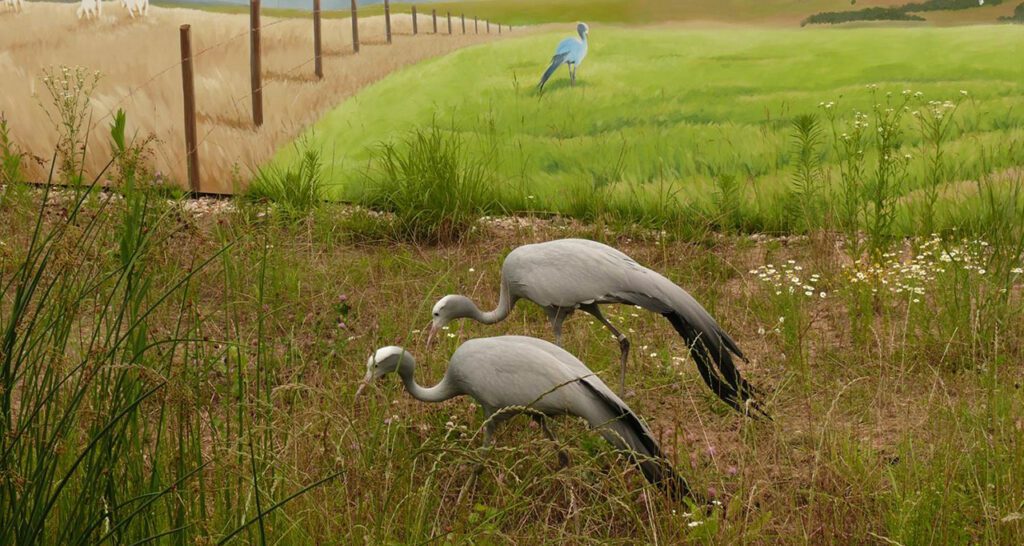Avian Influenza Updates & Resources

Avian Influenza Updates & Resources
Updated March 10, 2025
Highly Pathogenic Avian Influenza (HPAI) is a highly infectious disease of birds caused by type A strains of influenza virus. HPAI viruses can severely affect domestic and captive animals, wildlife, and is a potential deadly risk to human health. The viruses mainly occur in birds and are spread naturally by wild birds. A second strain is spread through poultry, and a third type related to bird strains is affecting dairy cattle. All these strains are also being detected in wild mammals and mammals living on dairy farms.
Outbreaks of HPAI have been a major cause of crane deaths in the past. It is estimated that over 10,000 Eurasian cranes were killed by the virus in Hungary in the winter of 2023. This is a tragic example of the potential for this virus to sicken wild birds, particularly cranes.
The International Crane Foundation continues to closely monitor the spread of HPAI. We take this issue very seriously. The health and wellbeing of both wild flocks and the cranes in human care at our Global Headquarters (Baraboo, Wis.) remains of the utmost importance to us, as well as our team. We employ a specialized full-time veterinary staff, which is prepared to take swift action to prevent and manage the spread of HPAI.
This page is intended to provide updates and resources regarding the current situation with HPAI. This page will be updated intermittently. For the most current information, check with your state agriculture, natural resources, or public health agency (see State Agency Resources below).
It takes a flock! Our teams are hard at work to protect cranes in wild flocks around the globe, as well as those in human care. You can support this work by becoming a member or donating.
Photo: Demoiselle Cranes flock in Inner Mongolia, China. Ciming Mei
Monitoring HPAI in Wisconsin
We need your help monitoring the current bird flu outbreak! Use this form to report the location and symptoms of sick or dead birds at your feeder that may be affected by HPAI.
If you encounter five or more sick or dead birds, you should also report this to the Wisconsin Department of Natural Resources Avian Influenza Site.
If you are outside Wisconsin, please see our State Agency Resources listing below for your state’s contact information.
Report sick or dead birds in Wisconsin
Expert Updates Webinar: Bird Flu Status and Resources with Dr. Diana Boon, Director of Conservation Medicine
(Recorded 2/11/2025)
Avian Influenza Frequently Asked Questions (FAQs)
Highly Pathogenic Avian Influenza (HPAI) is a highly infectious disease of birds caused by type A strains of influenza virus. HPAI viruses can severely affect domestic and captive animals, wildlife, and is a potential deadly risk to human health. Avian influenza mainly occurs in birds and is spread naturally by wild birds. A second strain is spread through poultry. A third type is affecting dairy cattle and is related to bird strains. All these strains are also being detected in wild mammals and mammals living on dairy farms.
Avian influenza viruses are classified as “low pathogenic” or “highly pathogenic” based on their genetic features. Influenzas are classified by two genetic characteristics, indicated by the letters H and N. Many viruses are of low pathogenicity and cause only minor or no clinical signs of infection. The strain of avian influenza currently of concern—Type A H5N1—is not a new virus and was first identified in 1959. Like other viruses, it has evolved over time into new versions of itself, which tend to be more potentially infectious and deadly.
Avian influenza mainly occurs in birds and is spread naturally by wild birds. A second strain is spread through poultry. A third type is affecting dairy cattle and is related to bird strains. All these strains are also being detected in wild mammals and mammals living on dairy farms. Smaller waterfowl, such as ducks and geese are more prone to carry the virus and transmit it to other birds if they are in proximity.
Poultry flocks continued to be culled to try to stop the spread of the virus and between January 10-Feb 10, 150 flocks have been culled. As of January 2, 2025, the USDA has confirmed cases of HPAI in dairy herds in 15 states, including in Michigan, Minnesota and Iowa. In wild birds, the number of affected birds and flocks is more difficult to monitor, but there are steady reports of deaths.
As of December 2024, human cases have remained limited to people with exposure to sick animals. The first human case of HPAI resulting in death was reported in Louisiana on January 6, 2025. Signs of HPAI in birds include sudden onset of severe illness and rapid death; outbreaks may occur with high mortality.
Current reporting suggests there are known ongoing outbreaks in several locations, including Rajasthan (Demoiselle Cranes) and Indiana, Kentucky, and Tennessee (Sandhill Cranes). Outbreaks of HPAI have been a major cause of crane deaths in the past. It is estimated that over 10,000 Eurasian cranes were killed by the virus in Hungary in the winter of 2023. In Japan, several thousand Red Crowned cranes were killed in 2021. This is a tragic example of the potential for this virus to sicken wild birds, particularly cranes.
The International Crane Foundation follows a strict biosecurity plan which regulates increasing levels of protections for the cranes, depending on the location and severity of the outbreak. We are continuing to closely monitor the spread of Highly Pathogenic Avian Influenza (HPAI). We take this issue very seriously. The health and wellbeing of the cranes held at the International Crane Foundation (ICF) remains of the utmost importance to us, as well as our team. ICF employs a specialized full-time veterinary staff, which is prepared to take swift action to prevent and manage the spread of HPAI.
Often, infected birds are found dead. Do not handle sick or dead wildlife. You may see them displaying abnormal neurological behavior, such as circling, head-down posture, twisted neck, or twitching.
Only experienced professionals wearing professional protective equipment should be involved in the removal of deceased birds or other wildlife that may have been exposed to HPAI. Improper handling of these remains could lead to further spread of the disease. Learn more about this here.
Note: Due to limited resources, state wildlife agencies and health departments may be unable to assist with individual cases. However, please continue to report sick or dead birds in your area to your state’s Department of Natural Resources. See state agency resources below.
Do not handle sick or dead wildlife. Report sick birds or bird mortalities to your state wildlife management agency immediately so that bird die-offs can be investigated and tested for HPAI. Though the impact on songbirds isn’t fully understood, bird baths, bird feeders, and other sites of artificial feeding may be an issue due to birds congregating.
Exercise caution if you spend time on poultry or dairy farms, in areas with high concentrations of waterfowl, or in other natural areas. It’s essential to help limit the spread of this virus. If you have dirt or mud on your shoes and have seen dead or sick birds, clean your shoes and disinfect them. It is also important to wash your vehicle if used in one of these high-risk areas.
It takes a flock! Our teams are hard at work to protect cranes in wild flocks around the globe, as well as those in human care. You can support this work by becoming a member or donating.
There is currently little data to know how exactly HPAI is affecting passerines (perching birds, song birds, backyard birds). Due to these unknowns, it never hurts to be overly cautious and remove your feeders! We recommend checking your local authorities for guidance on continued use of bird feeders (see state agency resources below).
Resources
Note: Some links, such as the CDC and other federal resources, may not be accessible at this time. Reporting of infections and the current status of the virus may be delayed. Please view our comprehensive list of State Agency Resources below. This list has been compiled with the best available information as of this writing. Report errors or updates to us at info@savingcranes.org.
Federal Agency Resources
| U.S. Center for Disease Control |
| USDA Animal and Plant Health Inspection Service |
| U.S. Fish & Wildlife Service |
State Agency Resources
Other Resources


